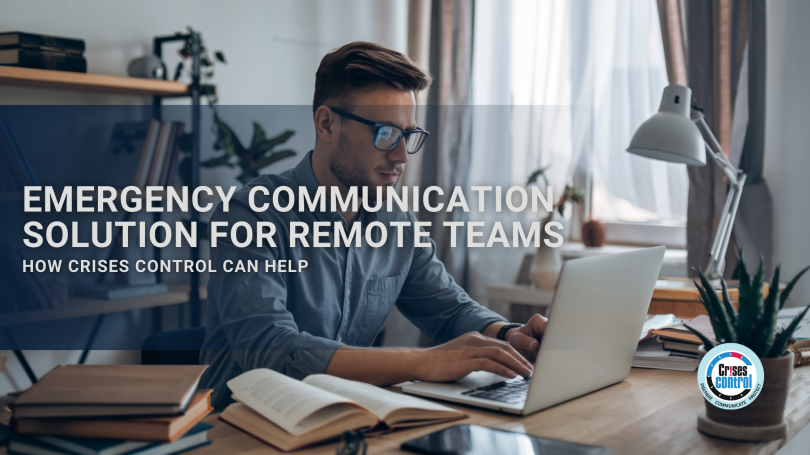Written by Anneri Fourie | Crises Control Executive
Remote work is here to stay. For many organisations, it’s become a permanent way of operating rather than a temporary measure. But while flexibility has improved, so too have the challenges of managing communication when things go wrong.
When a crisis hits, whether it’s a cyberattack, server outage, or something more serious like a natural disaster or political unrest, remote workers can’t rely on office-based protocols to stay informed or act fast. They need reliable, real-time communication that cuts through the noise and gives them exactly what they need to know, when they need to know it.
That’s where an emergency communication solution for remote teams comes in.
Why Remote Teams Need a Dedicated Emergency Communication Solution
Working remotely changes how your team connects, collaborates, and reacts. In a crisis, even a short delay in communication can lead to confusion, missed tasks, or serious risk to safety and business continuity.
Here’s what makes remote teams vulnerable during emergencies:
- No access to physical alerts: They can’t hear alarms or be gathered in a meeting room.
- Reliance on personal internet access: Downtime or poor mobile signal can cause message delays.
- More distractions and split focus: People working from home may miss email alerts or fail to spot an urgent message buried in chat threads.
- Different time zones or locations: Teams may be spread across regions, adding complexity to communication.
These issues can be the difference between a quick recovery and prolonged disruption.
What to Look for in an Emergency Communication Solution for Remote Teams
Not all emergency tools are built with remote-first needs in mind. A proper emergency communication solution for remote teams should focus on being accessible, fast, and easy to use, especially under pressure.
Here’s what to prioritise when assessing your options:
1. Mobile-First Access
Remote workers don’t always have laptops open. Your emergency system must be fully functional on a mobile app. They should be able to:
- Receive real-time alerts
- Confirm their safety
- Raise an SOS or panic alert
- View response plans and key documents
- Complete assigned tasks from their phone
Why this matters: In an emergency, speed is everything. A mobile-first design ensures nobody is left behind simply because they’re not at a desk.
2. Multi-Channel Delivery
Your messages should go out via every available channel:
- SMS
- Push notification
- Voice call
- Web alerts
Why this matters: People are distracted, and channels can go down. Reaching out in multiple ways increases the chances your message lands quickly and gets seen.
3. Confirmation and Acknowledgement Tracking
You need to know your messages aren’t just sent, they’ve been seen and acknowledged. Choose a system that:
- Tracks delivery status
- Logs who opened the alert
- Sends automatic reminders if there’s no response
Why this matters: It’s not enough to fire off a message and hope for the best. Confirmation tracking gives you confidence that your team is aware and safe, or highlights who still needs to be contacted.
4. Geo-Location Capabilities
If your staff travel, work in the field, or relocate frequently, geo-location can be a game-changer. It enables you to:
- See who’s in affected areas
- Send alerts only to impacted people
- Dispatch help where it’s actually needed
Why this matters: When a crisis hits a specific location, being able to filter who gets what based on geography avoids panic and gets the right message to the right person.
5. Automated Incident Plans
Instead of scrambling to work out what to do, choose a system that includes digital incident response plans. That way:
- Response steps are clear and easy to follow
- Everyone knows their role
- Tasks can be assigned automatically
- Progress is tracked in real-time
Why this matters: During a crisis, people don’t have time to find a PDF in a shared drive. Your plan should be just a tap away—simple, actionable, and always up to date.
6. Two-Way Communication
An emergency communication system shouldn’t just broadcast messages. It should also allow your team to reply, raise alarms, or ask for help.
Why this matters: Remote workers often feel isolated in a crisis. Giving them a direct line back to HQ or the crisis team can reduce fear, improve decision-making, and help resolve issues faster.
7. Cloud Independence and Resilience
If your entire operation runs on Microsoft or Google, what happens when those platforms go down? Choose a communication solution that operates independently of third-party infrastructure.
Why this matters: During major outages or cyber incidents, your ability to communicate should not be compromised. A resilient, private cloud setup with mobile connectivity is a safety net that remote teams can rely on.
How Crises Control Helps Remote Teams Stay Connected and Safe
Crises Control is built for moments when everything else fails. It’s more than a mass notification tool, it’s a complete emergency communication solution designed for hybrid and remote workforces.
Some of the features that support remote teams include:
- Ping Mass Notification that delivers messages across all key channels simultaneously
- Mobile app with full incident management features—users can report incidents, follow plans, complete tasks, and confirm safety on the go
- Geo-fencing and location-based targeting to isolate threats and tailor responses
- Automated escalation and failover workflows that keep communication going, even when people are unresponsive or systems are offline
- Full audit trail and reporting for post-incident reviews and compliance
- Hosted on a secure private cloud that remains operational even during major third-party outages
These features help organisations of every size and sector, from finance to manufacturing, healthcare to education, respond faster, reduce downtime, and keep people safe, wherever they are.
Best Practice Tips for Managing Remote Crises
Here are some quick wins to make sure your remote emergency communication plan works when it counts:
- Test your system regularly. Tabletop exercises help uncover gaps before a real crisis hits.
- Train your team. Everyone should know how to use the system and where to find plans.
- Keep contact details up to date. Out-of-date records are a common reason alerts don’t get through.
- Customise notifications. Avoid generic messages, make sure people know exactly what’s happening and what they should do.
- Use acknowledgements. Don’t assume people have seen your message. Require confirmation.
Final Thoughts
The shift to remote and hybrid working has created new vulnerabilities for organisations of all sizes. But it also creates an opportunity: with the right emergency communication solution, you can stay ahead of crises, protect your people, and keep your business running, even when everything else is falling apart.
If you’re ready to protect your remote team with reliable, fast, and secure emergency communication, get a free personalised demo of Crises Control today.
Request a FREE Demo









